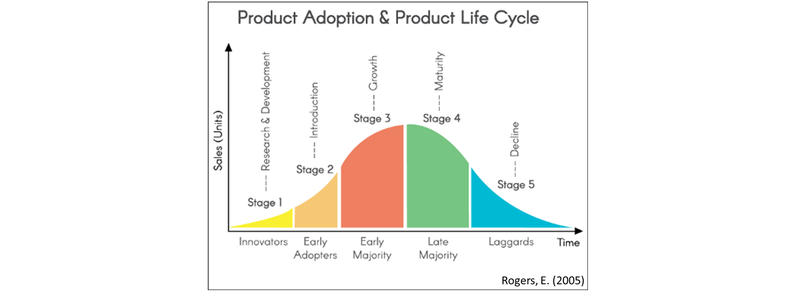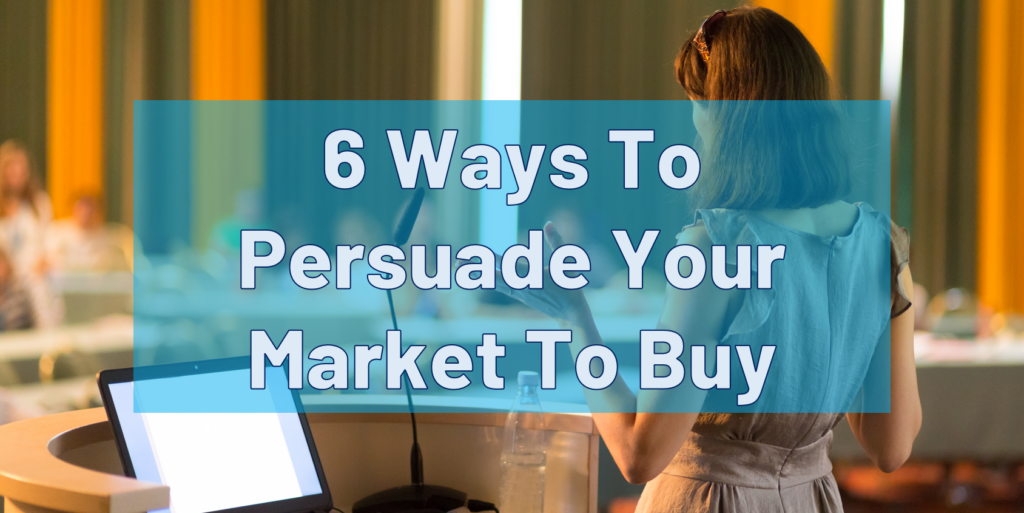In an ideal world you have created a business that uniquely solves a customers problems and you’re the only one out there providing a solution. The customer also happens to have a ton of disposable income and has no hesitations about trying out your new business… Sounds perfect right? Unfortunately, even with an excellent product or service that clearly solves a customer’s problems, there can still be hesitation on their part to be the first in line. Often, we will need to convince some of our first customers to take a chance on us. If we do a good job on the first crop of customers and create superfans out of them, our job gets a little easier as our superfans help spread the message and convince others to buy.

Everett Rogers (1970) first proposed that adoption of a new technology by the public would follow a bell shaped curve as seen above. In the beginning there would be hesitancy among buyers to try out something brand new. What if it didn’t work? Who knows how long it will last? Will it actually solve my problem? You get the idea. The same curve and process applies to most businesses. If you’ve ever heard of an “overnight success” it’s usually because the business is entering Stage 3, and we just hadn’t heard about it until then.
There is a small group however, called the Innovators who will be tempted to give your new product or service a shot. They are willing to be the first to try the new product out and are willing to accept that it may not yet be perfect. They are the group that you test your new ideas out on. They will become your future superfans who will tell the world, or at least your target market, all about you and your business. From there, if the business takes care of it’s quality and continues to grow with regard to customer feedback and needs, people will start spreading the message about your business and bring other customers in without you having to do anything to win them!
But how do you win these early Innovators? You will need to convince them in your marketing. Here are 6 Principles of Persuasion to include in your marketing mix from the research by Robert Cialdini:
Reciprocity
When someone does something nice for us, gives us something for free, or goes above and beyond for us, we internally feel driven to return the favor in some way. Without realizing it, there is an ‘I owe you’ situation created. This can be a great tool in your business. Consider strategies such as:
- Free trials
- Giving away content for free (charge for 1-on-1 services, larger segments of information such as books or courses, or affiliate links)
- Demonstrate how your business will help someone.
- Use “special” discounts
- Giveaway parts of a larger product for free that provide enough value to convince the customer to return for the rest.
Example: Easy Guitar by Brady gives away free mini lessons on how to play guitar on YouTube. He also offers the first lesson for free to potential clients. While this is a cost for him in terms of time, by doing a great job on the free content, it gives extraordinary value to the customer and will gently nudge them towards wanting to return the favor with their business. This of course assumes that the free content is good quality.
Scarcity
As soon as you tell somebody they can’t have something, doesn’t it often make them want it? The scarcity principle works by creating a situation in the customer’s mind where they fear missing out on an opportunity. This is also known as FOMO (fear of missing out).
If your business you can create this scarcity mindset by:
- Producing a limited number of an item
- Only offer the item for a set period of time
- Run sales, discounts, or early bird pricing that has a set expiry date
- Remind customers of how many products, time slots, or booking options remain
- Display countdown clocks, or remaining items on your sales pages or advertising
Example: Slicy Dicey produces handmade resin, multi-sided dice for board game and role play enthusiasts. Each set is completely unique because they are handmade and she only makes one of each. Immediately each new set she posts has a scarcity feeling because there is only one of them just like it!
Authority
If you are producing a new product or providing a new service, sometimes your reputation in that area may be enough to convince people to buy. How many of you bought the latest iPhone simply because Apple made it? People will line up for hours to be the first ones to have it, even though the public hasn’t really tested it yet to see what the faults are. Of course, very few of us are Apple, but we can still employ different methods of building authority and giving customers reason to trust that what we are providing is good quality and will solve a problem for them:
- List your certifications
- Display your awards
- Show customer testimonials from your early testing and prototype stages
- If you are ranked using a star or rating system, display that rank
- Communicate your experience or education in the area of the business
- Get endorsed or recommended by influencers that your target market care about.
Example: When I first started advertising The Simple StartUp Virtual Courses I didn’t have prior course successes to lean upon. This was the first dip into that space. However, I was able to put things such as “author of The Simple StartUp” (while being a published author is something anyone can do, it does carry a little bit of a wow factor). I was also able to name things such as being a Certified Financial Education Instructor, and my years of experience in the classroom helping my students to start their own businesses. ChooseFI publicly backed the course and Brad Barrett gave the book a glistening review. All of these led to the first course selling out and has made each course easier to sell as my authority in the space grows.
Consistency
This is the principle that also helps Apple make all those sales. People like to stick with the things they are already doing, things they have said, and brands they know. It can be hard to change. How many of you stick with the mediocre dentist, hairdresser, or bank because it’s simply what you know?
There are some actions we can do to help customers feel like the jump to trying out our business is not that big. They include things like:
- Point out the similar products and services the customer is already buying (and then why yours is better)
- Try to get the customer to buy cheap and small items from your store first before trying to convince them of a larger sale. People will be more easily persuaded to try something for less than $5, and once they have tried something from your business, stepping up to a more expensive item is consistent with what they already do (buying from you)
- Give free samples and trials, then look for the upgrade or purchase later once they are already comfortable consuming what you provide.
Example: Face Plant Maskz piggy backed on the new mask wearing mandates by selling a line of tie-dye face masks. In some of her advertising and sales, she was able to point out that customers are already buying facemasks, and there aren’t really any massive known brands on Etsy, so you could take a shot on her shop. Once customers had made that first purchase, she sent them offers of larger packs of facemasks.
Liking
Prepare for a shock… Customers prefer to buy from people they like! Crazy right? Taking the time to build a relationship with your customer will solidify in their minds that you are trustworthy and the right person to buy from. Ways to build that likability factor:
- Show your personality in your marketing. It shouldn’t sound like a robot is communicating with people
- Create videos and audio clips to share stories about yourself and your business. What is your origin story? Why are you selling the things you are?
- Ask the customer about themselves first, get them to share their problems, and then present the solution
- Smile, make eye contact, have open and approachable body posture
- Give the customer some insights into your likes, hobbies, quirks, etc. If they find a common connection with you, they start to build a connection.
- Give sincere compliments to your customers.
Example: How many times have you walked into a store and been greeted upon entering. Just that small act of acknowledging your presence, and welcoming you openly to the store makes us feel that bit special (if it seems genuine, and not annoying of course!).
Consensus
Finally we look to people’s tendency to copy what others do. To be sheep. To follow the crowd. When we are faced with a decision such as buying a new item that we aren’t super familiar with (new car, tv, washing machine), we tend to look to others for guidance. This can be searching online for review websites to get others opinions, reading the reviews on Google or Amazon, stopping people in the street and asking them what they think of their shoes (are they comfortable? Durable?), or calling up your best friend to ask them how they are spending the weekend and can you do that too. It’s a built-in laziness mechanism that helps us to make better decisions, and we need to borrow that for our own businesses.
Here’s some ways to do it:
- Get reviews and testimonials for your business ASAP. Make them very obvious and easy to see on your marketing material.
- Make superfans out of your first 100 customers and ask them to tell their friends. A review from a trusted source such as a friend or family member is WAY MORE powerful than a review online or advertisement with a testimonial.
- Seek out the influencers and ask them to use or recommend or promote your business. Influencers can be anything from celebrities to the popular kids in school. People with large social media followings are a good source too.
- In your marketing, point out how many sales you’ve already had or how many people have benefitted from your services already. Encourage them to hop on the bandwagon!
Example: I recently bought a new wireless mouse for my computer. I based my decision on nothing but the reviews on Amazon. Which one had the most reviews and the highest star rating. Since it was only a $10 purchase, I didn’t go deep in my research. If the price of your product or service is on the lower end, consensus will play a larger part in decision making since the dollar amount is not worth our time to do our own investigation. The ‘new to me’ car I’m considering on the other hand is going to get way more research, lots of test drives, reviews from reliable sources, etc.
There you have it. 6 ways that you can incorporate the principles of persuasion in your marketing. Remember your sales process will most likely start off quite slowly, but each sale may help drive 2 more, and the growth will eventually accelerate. Treat your customers right and create those superfans!
If you liked the contents of this article please help me by sharing it with your own networks. See what I did there? But seriously, that would be very helpful in my goal of growing the reach of this business advice and helping more future business owners get started!


